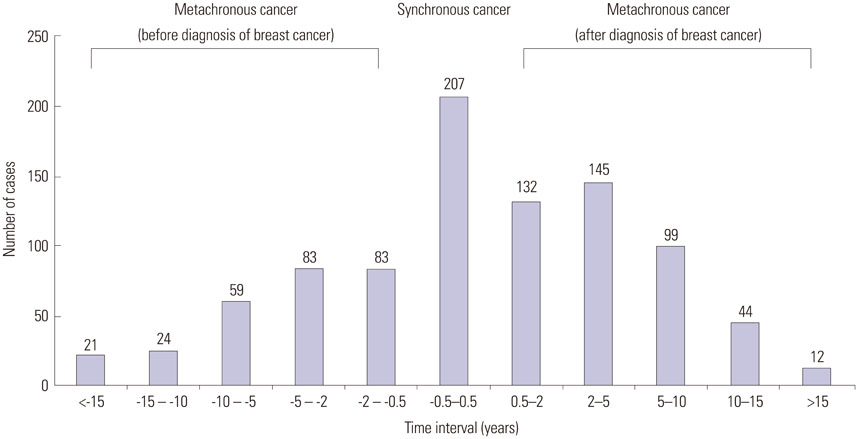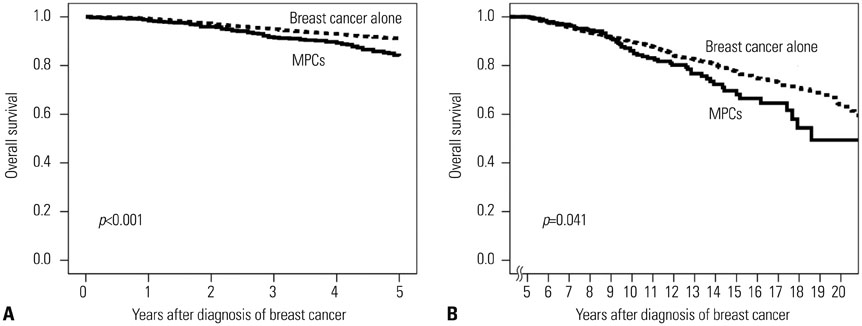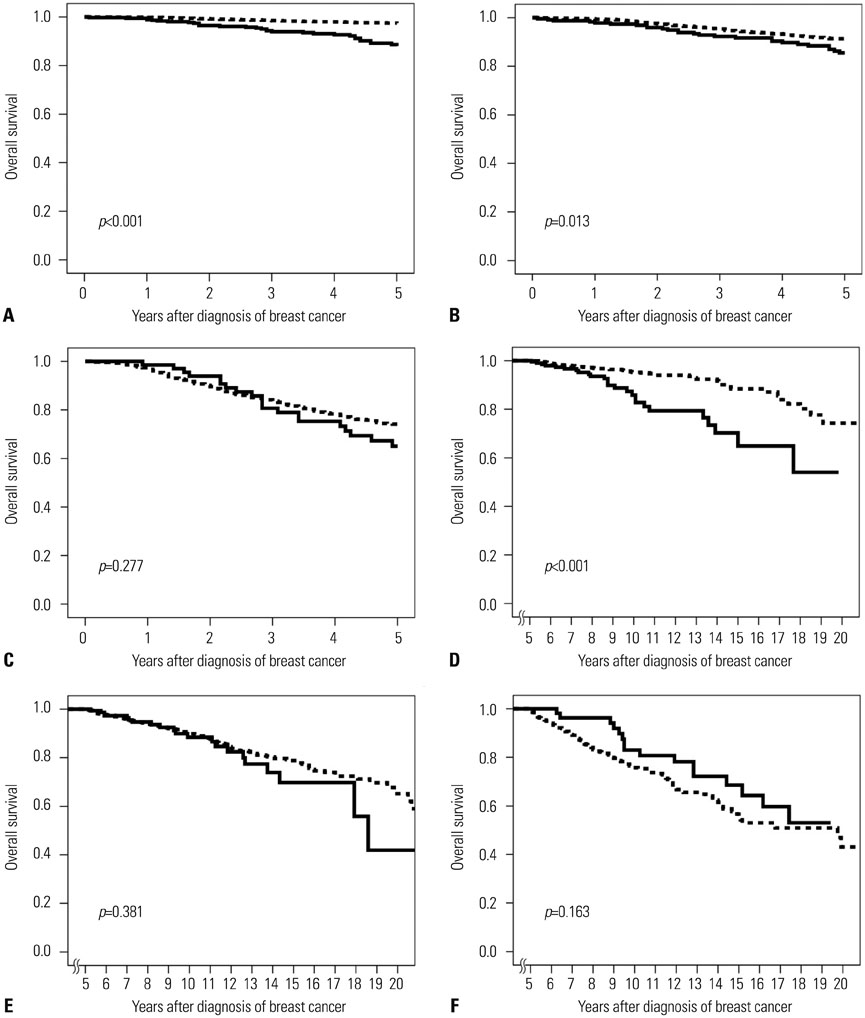Yonsei Med J.
2015 Sep;56(5):1213-1220. 10.3349/ymj.2015.56.5.1213.
Characteristics and Survival of Breast Cancer Patients with Multiple Synchronous or Metachronous Primary Cancers
- Affiliations
-
- 1Department of Surgery, Yonsei University College of Medicine, Seoul, Korea. psh1025@yuhs.ac
- KMID: 2163611
- DOI: http://doi.org/10.3349/ymj.2015.56.5.1213
Abstract
- PURPOSE
Newly developed extra-mammary multiple primary cancers (MPCs) are an issue of concern when considering the management of breast cancer survivors. This study aimed to investigate the prevalence of MPCs and to evaluate the implications of MPCs on the survival of breast cancer patients.
MATERIALS AND METHODS
A total of 8204 patients who underwent surgery at Severance Hospital between 1990 and 2012 were retrospectively selected. Clinicopathologic features and survival over follow-up periods of < or =5 and >5 years were investigated using univariate and multivariate analyses.
RESULTS
During a mean follow-up of 67.3 months, 962 MPCs in 858 patients (10.5%) were detected. Synchronous and metachronous MPCs were identified in 23.8% and 79.0% of patients, respectively. Thyroid cancer was the most prevalent, and the second most common was gynecologic cancer. At < or =5 years, patients with MPCs were older and demonstrated significantly worse survival despite a higher proportion of patients with lower-stage MPCs. Nevertheless, an increased risk of death in patients with MPCs did not reach statistical significance at >5 years. The causes of death in many of the patients with MPCs were not related to breast cancer. Stage-matched analysis revealed that the implications of MPCs on survival were more evident in the early stages of breast disease.
CONCLUSION
Breast cancer patients with MPCs showed worse survival, especially when early-stage disease was identified. Therefore, it is necessary to follow screening programs in breast cancer survivors and to establish guidelines for improving prognosis and quality of life.
MeSH Terms
-
Adult
Aged
Breast/pathology
Breast Neoplasms/diagnosis/*mortality
Female
Humans
Middle Aged
Multivariate Analysis
Neoplasm Metastasis
Neoplasm Staging
Neoplasms, Multiple Primary/diagnosis/*mortality
Neoplasms, Second Primary/diagnosis/*mortality
Prognosis
*Quality of Life
Republic of Korea/epidemiology
Retrospective Studies
Survival Analysis
Figure
Cited by 2 articles
-
Lymphangiogenesis in Breast Cancer Correlates with Matrix Stiffness on Shear-Wave Elastography
Yoon Jin Cha, Ji Hyun Youk, Baek Gil Kim, Woo Hee Jung, Nam Hoon Cho
Yonsei Med J. 2016;57(3):599-605. doi: 10.3349/ymj.2016.57.3.599.Clinical Characteristics and Prognosis Associated with Multiple Primary Cancers in Breast Cancer Patients
Bong Kyun Kim, Se Jeong Oh, Jeong-Yoon Song, Han-Byoel Lee, Min Ho Park, Yongsik Jung, Woo-Chan Park, Jina Lee, Woo Young Sun,
J Breast Cancer. 2018;21(1):62-69. doi: 10.4048/jbc.2018.21.1.62.
Reference
-
1. Siegel R, Naishadham D, Jemal A. Cancer statistics, 2013. CA Cancer J Clin. 2013; 63:11–30.
Article2. DeSantis C, Ma J, Bryan L, Jemal A. Breast cancer statistics, 2013. CA Cancer J Clin. 2014; 64:52–62.
Article3. Jung KW, Won YJ, Kong HJ, Oh CM, Seo HG, Lee JS. Cancer statistics in Korea: incidence, mortality, survival and prevalence in 2010. Cancer Res Treat. 2013; 45:1–14.
Article4. Ko BS, Noh WC, Kang SS, Park BW, Kang EY, Paik NS, et al. Changing patterns in the clinical characteristics of Korean breast cancer from 1996-2010 using an online nationwide breast cancer database. J Breast Cancer. 2012; 15:393–400.
Article5. Shin DW, Cho B, Kim SY, Jung JH, Park JH. Management of cancer survivors in clinical and public health perspectives: current status and future challenges in Korea. J Korean Med Sci. 2013; 28:651–657.
Article6. Travis LB, Demark Wahnefried W, Allan JM, Wood ME, Ng AK. Aetiology, genetics and prevention of secondary neoplasms in adult cancer survivors. Nat Rev Clin Oncol. 2013; 10:289–301.
Article7. Warren S, Gates O. Multiple primary malignant tumors: a survey of the literature and a statistical study. Am J Cancer. 1932; 16:1358–1414.8. Curtis RE, Freedman DM, Ron E, Ries LAG, Hacker DG, Edwards BK, et al. New malignancies among cancer survivors: SEER cancer registries, 1973-2000. Bethesda, MD: National Cancer Institute;2006. NIH Publ. No. 05-5302.9. Working Group Report. International rules for multiple primary cancers (ICD-0 third edition). Eur J Cancer Prev. 2005; 14:307–308.10. Jung SH, Kwak SS, Kim SC, Park MK, Lee GS, Kim HJ, et al. Clinical characteristics of multiple primary cancer in breast cancer patients. J Breast Cancer. 2007; 10:263–268.
Article11. Greene FL, Page DL, Fleming ID, Fritz AG, Balch CM, Haller DG, et al. AJCC cancer staging manual. 6th ed. New York, NY: Springer-Verlag;2002.12. Hammond ME, Hayes DF, Wolff AC, Mangu PB, Temin S. American society of clinical oncology/college of american pathologists guideline recommendations for immunohistochemical testing of estrogen and progesterone receptors in breast cancer. J Oncol Pract. 2010; 6:195–197.
Article13. Dong C, Hemminki K. Second primary neoplasms in 633,964 cancer patients in Sweden, 1958-1996. Int J Cancer. 2001; 93:155–161.
Article14. Tabuchi T, Ito Y, Ioka A, Miyashiro I, Tsukuma H. Incidence of metachronous second primary cancers in Osaka, Japan: update of analyses using population-based cancer registry data. Cancer Sci. 2012; 103:1111–1120.
Article15. Molina-Montes E, Pollán M, Payer T, Molina E, Dávila-Arias C, Sánchez MJ. Risk of second primary cancer among women with breast cancer: a population-based study in Granada (Spain). Gynecol Oncol. 2013; 130:340–345.
Article16. Evans HS, Lewis CM, Robinson D, Bell CM, Møller H, Hodgson SV. Incidence of multiple primary cancers in a cohort of women diagnosed with breast cancer in southeast England. Br J Cancer. 2001; 84:435–440.
Article17. Mazzaferri EL. Managing thyroid microcarcinomas. Yonsei Med J. 2012; 53:1–14.
Article18. Mellemkjær L, Christensen J, Frederiksen K, Pukkala E, Weiderpass E, Bray F, et al. Risk of primary non-breast cancer after female breast cancer by age at diagnosis. Cancer Epidemiol Biomarkers Prev. 2011; 20:1784–1792.
Article19. Kirova YM, De Rycke Y, Gambotti L, Pierga JY, Asselain B, Fourquet A, et al. Second malignancies after breast cancer: the impact of different treatment modalities. Br J Cancer. 2008; 98:870–874.
Article20. Arriagada R, Averbeck D, Dahl AA, Darby S, Fosså S, Friberg S, et al. OECI Workshop on late side-effects of cancer treatments. Eur J Cancer. 2009; 45:354–359.
Article21. Andersson M, Jensen MB, Engholm G, Henrik Storm H. Risk of second primary cancer among patients with early operable breast cancer registered or randomised in Danish Breast Cancer cooperative Group (DBCG) protocols of the 77, 82 and 89 programmes during 1977-2001. Acta Oncol. 2008; 47:755–764.22. Oeffinger KC, Baxi SS, Novetsky Friedman D, Moskowitz CS. Solid tumor second primary neoplasms: who is at risk, what can we do? Semin Oncol. 2013; 40:676–689.
Article23. Kang E, Kim SW. The korean hereditary breast cancer study: review and future perspectives. J Breast Cancer. 2013; 16:245–253.
Article24. Corkum M, Hayden JA, Kephart G, Urquhart R, Schlievert C, Porter G. Screening for new primary cancers in cancer survivors compared to non-cancer controls: a systematic review and meta-analysis. J Cancer Surviv. 2013; 7:455–463.
Article25. Suh B, Shin DW, Kim SY, Park JH, Chang WY, Lim SP, et al. Mode of primary cancer detection as an indicator of screening practice for second primary cancer in cancer survivors: a nationwide survey in Korea. BMC Cancer. 2012; 12:557.
Article26. Cho J, Guallar E, Hsu YJ, Shin DW, Lee WC. A comparison of cancer screening practices in cancer survivors and in the general population: the Korean national health and nutrition examination survey (KNHANES) 2001-2007. Cancer Causes Control. 2010; 21:2203–2212.
Article27. Yi M, Cormier JN, Xing Y, Giordano SH, Chai C, Meric-Bernstam F, et al. Other primary malignancies in breast cancer patients treated with breast conserving surgery and radiation therapy. Ann Surg Oncol. 2013; 20:1514–1521.
Article28. Shin DW, Baik YJ, Kim YW, Oh JH, Chung KW, Kim SW, et al. Knowledge, attitudes, and practice on second primary cancer screening among cancer survivors: a qualitative study. Patient Educ Couns. 2011; 85:74–78.
Article29. Shin DW, Kim Y, Baek YJ, Mo HN, Choi JY, Cho J. Oncologists experience with second primary cancer screening: current practices and barriers and potential solutions. Asian Pac J Cancer Prev. 2012; 13:671–676.
Article




